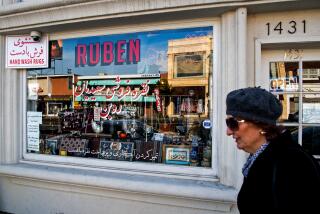‘Cinema’ Celebrates Iranian Film World
- Share via
Mohsen Makhmalbaf’s “Once Upon a Time, Cinema,” which commences an open-end regular run Friday at the Monica 4-Plex, is a dazzling, whirling dervish of a movie in which one of the last of Persia’s extravagant Qajar shahs (Ezzatollah Entezami) falls in love with the newly invented movies, and then with one of the Iranian cinema’s early screen heroines.
The heroine magically falls off a cliff only to materialize before the shah’s eyes in the royal Golestan Palace, that fanciful fairy-tale structure still standing in the center of Tehran.
Makhmalbaf accomplishes much in this tragicomic Surrealist triumph: He celebrates the magical power of the medium and its unparalleled capacity for blurring reality and fantasy as a way of making a subtle, critical commentary on his country’s chronic censorship of filmmakers. He also celebrates the Iranian cinema itself, which unfolds as a panorama glimpsed in clips at the shah’s interminable screenings at Golestan.
The film’s cinematographer (Mehdi Hashemi), a wistful Chaplin look-alike, meanwhile naively sees the camera as an instrument to tell the truth that will set oppressed people free.
One of the most inspired of Makhmalbaf’s countless conceits is to show the shah so carried away with the movies he wants to become a screen star himself, only to find himself transported from the fantasy life of his palace to the hard lot of the Iranian peasant, as dramatized in a neo-realist-style film.
“Once Upon a Time, Cinema” is constantly exhilarating, alternately hilarious and rueful, at once a glittering evocation and a criticism of glorious Qajar Dynasty extravagance in its final years.
Hong Kong Adventures: Fridays and Saturdays at midnight, the Monica presents two vintage Hong Kong period adventures rediscovered by Filmhaus, the enterprising distributor that revived the delightful “Master of the Flying Guillotine.”
Produced by Hwa Studios, Chang Peng-I’s “Shaolin Kung Fu Mystagogue” (released in the United States in 1977 as “Killer Fist”) is typical of Asian costume epics in that a convoluted plot and a thicket of palace intrigue hide an essentially simple tale; in this instance, a brother (Huang Chia-Ta, a.k.a. Carter Wong) and sister (Hsu Feng), martial-art whizzes, and Ming loyalists bravely try to free their sovereign and overthrow the oppressive new Ming Dynasty. A key setting is the Shaolin Temple, where its fearless head priest--the mystagogue of the film’s title--is a Ming sympathizer, simultaneously a spiritual leader and a kung-fu master.
In a perverse stroke of luck, Filmhaus was unable to locate a print of Liu Kuo Shung’s 1978 “A Time for Murder,” which means it’s being shown in its hilariously awful English-dubbed version. Clearly primitive in any language, it’s a cockamamie blend of exotic folklore and horror worthy of a Maria Montez vehicle of the ‘40s.
It seems that there’s this tiny, snake-ridden tribal mountain kingdom just outside China’s northwestern border where women concoct a witch’s brew, allowing them to impregnate men with icky larva.
It’s delirious midnight fun; Huang Chia-Ta is also featured in this film.
Information: (310) 394-9741.
Morgue Thriller: By dreary contrast, the Sunset 5’s new Friday-Saturday midnight show, James Cummins’ “The Boneyard,” is a routine supernatural thriller set in a small-town morgue plagued with ghouls and featuring such veterans as Ed Nelson (as a cop), Norman Fell (the morgue’s pathologist) and Phyllis Diller (the morgue’s nasty night receptionist whose yippy French poodle at least provided the film with a silly finish).
Deborah Rose manages some strong moments as a local psychic haunted by her powers.
You may not be able to stay awake through this one.
Information: (213) 848-3500.
More to Read
Only good movies
Get the Indie Focus newsletter, Mark Olsen's weekly guide to the world of cinema.
You may occasionally receive promotional content from the Los Angeles Times.










